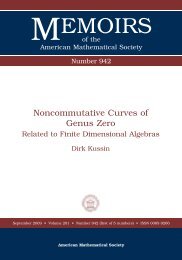University of Paderborn Department of Mathematics Diploma Thesis ...
University of Paderborn Department of Mathematics Diploma Thesis ...
University of Paderborn Department of Mathematics Diploma Thesis ...
You also want an ePaper? Increase the reach of your titles
YUMPU automatically turns print PDFs into web optimized ePapers that Google loves.
28 CHAPTER 2. STABLE IDEALSby Lemma 1.1.Since m 1 > . . . > m r−1 > m r , it follows in particular (m 1 , . . . , m r−1 ) : m r ⊂ (x 0 , . . . , x lr−1).Claim. (m 1 , . . . , m r−1 ) : m r ⊃ (x 0 , . . . , x lr−1).Pro<strong>of</strong> <strong>of</strong> the Claim. Since I is stable and m r = x a r00 · . . . · x a r,lr−1l r−1· x a rlrl r, we know thatis an element <strong>of</strong> I. Since I is a monomialthe monomial ˜m := x a r00 · . . . · x a r,lr−1+1l r−1ideal, the monomial ˜m is divisible by one <strong>of</strong> the generators <strong>of</strong> I. Surely, m r does not divide· x a rlr −1l r˜m. Hence, there is m ′ ∈ {m 1 , . . . , m r−1 } such that m ′ · x c 00 · . . . · x c lrl rm ′ = x a r0−c 00 · . . . · x a r,lr−1+1−c lr−1l r−1· x a rlr −1−c lrl r.= ˜m, i.e.Because m ′ > m r in lexicographic order we may conclude that the first non-zero entry <strong>of</strong>the exponent vector((a r0 − c 0 ) − a r0 , . . . , (a r,lr−1 + 1 − c lr−1) − a r,lr−1, (a rlr − 1 − c lr ) − a rlr )is positive. Since c j ≥ 0, 0 ≤ j ≤ l r , it follows c lr−1 = 0. This providesgcd(m ′ , m r ) = x a r0−c 00 · . . . · x a r,lr−1l r−1· x a rlr −1−c lrl r,m ′and we getgcd(m ′ , m r ) = x l r−1, which shows that x lr−1 is contained in the set <strong>of</strong> generators<strong>of</strong> the ideal (m 1 , . . . , m r−1 ) : m r .Next we conclude that x lr−2 is a generator <strong>of</strong> (m 1 , . . . , m r−1 ) : m r by using the fact that˜m := x a r00 ·. . .·x a r,lr−2+1l r−2·x a r,lr−1l r−1·x a rlr −1l ris an element <strong>of</strong> I. Iteration <strong>of</strong> this process provides(m 1 , . . . , m r−1 ) : m r ⊃ (x 0 , . . . , x lr−1).Now we have (m 1 , . . . , m r−1 ) : m r = (x 0 , . . . , x lr−1) and finish the pro<strong>of</strong> <strong>of</strong> the theorem: Asa consequence <strong>of</strong> the latter identity, we getWe take advantage <strong>of</strong>R/((m 1 , . . . , m r−1 ) : m r ) ∼ = K[x lr , . . . , x n ] ∼ = K[x 0 , . . . , x n−lr ].H K[x0 ,...,x n−lr ](t) =1 (1 − t)lr=(1 − t)n−lr+1(1 − t) . n+1Since (m 1 , . . . , m r−1 ) still is a stable ideal, we know the Hilbert series <strong>of</strong> R/(m 1 , . . . , m r−1 )by induction. Together with (∗), we obtainH R/I (t) = 1 − ∑ r−1i=1 (1 − t)li · t d i(1 − t) lr− t dr ·(1 − t) n+1 (1 − t) = 1 − ∑ ri=1 (1 − t)li · t d i.n+1 (1 − t) n+1
















